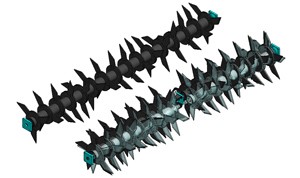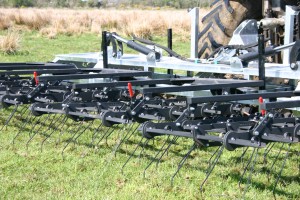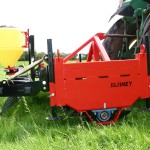Boost grass and save fertilizer. The Blaney Aerator releases the equivalent of 50kg of nitrates per hectare.
Compaction of grassland is a common problem caused by livestock and heavy machinery which reduces grazing potential.
The Aerator blades cut through the compacted layers of soil to open up fissures for better drainage, more efficient use of nutrients and healthier grass. A Blaney Aerator is a worthwhile investment that will last for years, boost your grass yield and reduce your fertiliser expense, improve slurry matter retention and nutrient uptake by roots
Advantages
- Oxygen introduced into soil
- Increased root development for better grass growth
- Improved Nitrogen fixation for legumes e.g. clover
- Increased microbial action for better use of fertiliser- Reduce fertiliser bills
- Soil recovers quicker after mowing
- Surface drainage improved (less rainwater & slurry run off)
- Less compaction
- Less poaching by livestock
For smaller applications or hard to reach areas why not try our ATV Aerators manufactured by Quad-X our ATV machinery division, available in 1.2m widths.
Aeration – What are the benefits?
What does it do?
As part of a well managed grassland system, aeration will introduce air to the grass roots and soil to help root development to alleviate compaction, improve drainage, reduce slurry and fertilizer runoff. In short, aeration will ultimately grow more grass. Slit aeration improves microbial activity and helps nutrient and crop debris breakdown.
What it achieves/benefits?
The Blaney Agri Aerator range was initially established for organic grassland farmers seeking to grow more grass without artificial fertiliser, a task that wasn’t simple. Following much ongoing innovation, the resulting design was to provide an alternated slit pattern that cuts a deep slit through compact layers of soil to allow air to circulate oxygen and soluble nitrates like iron, to move freely and not be built up within the compacted soil layers. The tapered blade edge provides a clean entrance and exit with a blade shank that opens the sod on exit to minimise sod lift that can cause contamination that is especially problematic in silage ground. Through using the Blaney Aerator it can release the equivalent of 50kg of nitrates per hectare. A recent on-farm trial found spring slit aeration boosted grass production by 0.8t/ha. Aerated soil can make better use of fertiliser since the soil temperature is at least half a degree warmer in comparison to non treated soil. It is a waste of time and money to apply fertiliser to grass in compacted soil which cannot fully utilise fertiliser.
The Blaney Agri Aerator allows nitrates from fertiliser or slurry to be absorbed into the soil, preventing the expensive fertiliser running off or being washed off the ground. The risk of fertiliser run-off will increase by as much as 50-60% in heavily compacted soils. Aerating increases root development and this results in boosting your grass yield rates. Through the use of Blaney Agri Aerator you will reduce fertiliser bills and grow more grass.
In what circumstances would you use it?
Aeration is the ideal remedy for compaction up to 15cm deep. Compaction up to 10cm deep is known as surface capping and is often caused by grazing in wet conditions, high stocking densities and rainfall on new cultivations. Machinery can cause compaction up to 15cm deep with silage and muckspreading the key causes. Compacted waterlogged soil is often identified by areas of standing water or the growth of rushes, fog and other water loving plants. You may also notice a reddish tinge which indicates plant stress. To find out if you have a soil compaction problem, you can simply dig a hole using a spade and look how far the roots and moisture extend down to. Compaction starts where the spade meets resistance. Look for any noticeable changes in soil structure.
Best time to do it and ideal conditions?
Timing is the most important factor to get the best results from aeration. The best time to aerate is when the ground is dry enough to avoid surface damage by the tractor, but have enough moisture to allow the aerator spikes to penetrate but not too wet that cause smearing of the slit sides. Spring and autumn tend to be the ideal time, especially pre slurry and fertiliser application for best grass yield improvement.
In Spring or Autum the Blaney Agri one pass system is effective: The Duo System Aerator with tines for dethatching removes moss and dead vegetation to open the soil surface allowing it to “Breathe” more oxygen and boost grass.
Triple System: For those that want to further improve grass yields while reducing their fertiliser bill, this One Pass Grassland System includes and Aerator with tines and a remote control electrobroadcaster for dethatching and over sowing. With the addition of the seeder/ broadcaster, grass varieties and clover can be stitched in for bare and heavily poached areas improving grass quality and quantity, reducing weed uptake in these areas. The oversowing of clover can improve nitrogen fixation.
When should you not do it?
It is best not to aerate in overly wet or dry ground conditions. When ground conditions are too wet it will cause more compaction problems. Although aerating will improve surface drainage it cannot solve underlying land drainage problems which occurs in areas of ponding. Also when soil is too wet aeration will ‘smear and seal’ the sides of the slit reducing the ability of the oxygen to penetrate a normal open type slit. When ground is too dry the Aerator Blades may sink in enough to be effective, or if weight is applied to the aerator to achieve penetration in dry conditions an extended dry period can cause excessive cracking and moisture loss as well as unnecessary wear or damage to your machine.
If compaction is deeper than 15cm deep, a subsoiler would be the best solution, rather than an aerator.
What depth?
The Blaney Agri aerator has an impressive working depth of 180mm, which provides a longer lasting and more effective slit compared to shorter ones
If it gets too dry, what is the minimum depth you can work at before it becomes pointless?
Depends on the root structure, but ideally you want the blades to penetrate by 100mm at least split angled machines should be operated in ‘straight sliting position only’ in drier conditions to achieve penetration. Additional weight can be added responsibly(Check machines weight capacity limit and tractors carrying capacity) to the Blaney Agri aerator to help in drier conditions but avoid conditions that are too dry, On larger folding models weight should be added to centre unit.
Best practice in terms of speed and direction of travel?
5mph. Direction of travel should always be to and from the main drains as the Blaney aerators especially the 5 blade models provide a continuous groove in the soil resulting in a mini trench therefore if working on sloping ground it will be safer to travel up and down slopes rather than across. The important thing is to ensure even coverage, and only operate with the aerator down while driving straight, Lift machine to change direction, do not turn with blades in the ground.
How aggressive in terms of blade angles and how many blades for what circumstance/conditions?
 Blaney Agri offer adjustable split angled models which offer up to a 12 degree angle adjustment, allowing the blades to penetrate and exit at an angle to open up wider fissures to help shatter compacted soil for better drainage. The extra angle is essential in organic type soils where the soil needs a bigger hole as it tends to close in with the smaller slit shortly after. Blaney Agri offer the choice of 3, 4 or 5 blades. To make your time in the field generate better results, more blades means better drainage thanks to the peaks in the drains created being more continuous for bigger volume fissures. This reduces the troughs which will hold water, leaving more room for air. 3 blades would be suitable for sandy soil, with 4 blades for heavy soil and 5 blades for heavy poached and organic type soil. The angle is adjustable on split angle machines and should be adjusted Straight in Dry conditions and more angled in wetter conditions.
Blaney Agri offer adjustable split angled models which offer up to a 12 degree angle adjustment, allowing the blades to penetrate and exit at an angle to open up wider fissures to help shatter compacted soil for better drainage. The extra angle is essential in organic type soils where the soil needs a bigger hole as it tends to close in with the smaller slit shortly after. Blaney Agri offer the choice of 3, 4 or 5 blades. To make your time in the field generate better results, more blades means better drainage thanks to the peaks in the drains created being more continuous for bigger volume fissures. This reduces the troughs which will hold water, leaving more room for air. 3 blades would be suitable for sandy soil, with 4 blades for heavy soil and 5 blades for heavy poached and organic type soil. The angle is adjustable on split angle machines and should be adjusted Straight in Dry conditions and more angled in wetter conditions.
How long do the effects of the aeration last?
The effects of aeration depends on the level of compaction before aeration, soil type and the overall management of the soil and sward condition and also on weather conditions and level of ground compaction and stocking densities following aeration. However best results have been found when initially using Spring and again in Autumn.
How can you maintain the effects once you have aerated?
It is important to manage the soil and pasture well following aeration to prolong the advantageous effects. This management involves issues such as crop nutrition, soil compaction, sward condition and weed infestation





















